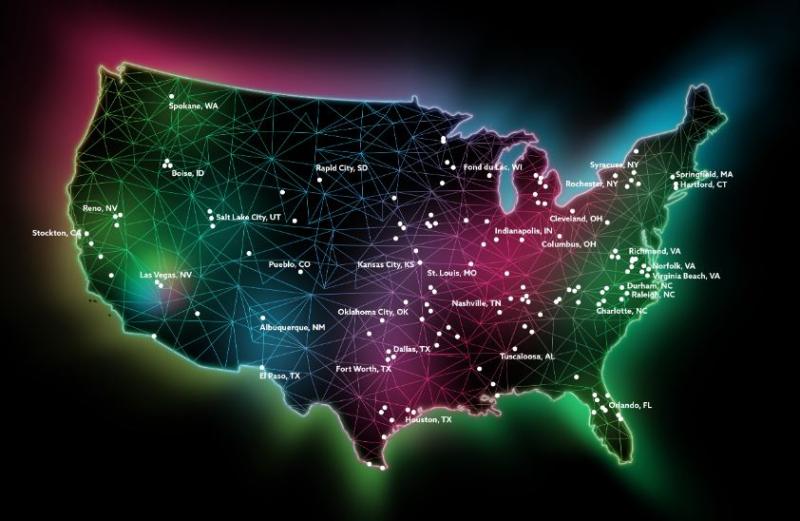Dish announced today that as of June 14, it’s offering 5G broadband service to more than 20% of the U.S. population.
June 14 marked the government deadline for Dish to meet the 20% population milestone, and while Dish executives signaled their confidence leading up to the target, it wasn’t always a sure thing.
Dish said its 5G broadband service is 3GPP Release 15 enhanced mobile broadband (eMBB) compliant and runs through its 5G core. Its 20% coverage uses AWS-4, lower 700 MHz E Block and AWS H Block spectrum.
Dish first launched its wireless service in Las Vegas in May and since then expanded service to more than 120 cities across the country. Consumers are directed to Genesis5G.com to see if they’re in a location where service is available. Service is being offered for $30/month.

Indeed, in its announcement today, Dish said its 5G offering marks a major milestone in “building the world’s most advanced cloud-native 5G open RAN network,” as Dish aims to change the way the world communicates.
Dave Mayo, executive vice president of network development at Dish Wireless, gave a nod to the many vendors that are part of the company’s mission.
"This is a big moment for Dish as we connect customers across the country with America's first and only cloud-native open RAN network," Mayo said in a statement. "This milestone was achieved through the collaboration, ingenuity and hard work of the Dish team and our numerous partners, including AWS, Cisco, CommScope, Dell, Fujitsu, Intel, JMA, Mavenir, Nokia, Oracle, Palo Alto, Qualcomm, Samsung and VMware. We're the only major network in the world built primarily with American vendors."
Devices
One of the big questions is what kind of devices Dish is able to offer out of the gate. With the Las Vegas launch, the only available device was the Motorola Edge+ for $900.
Dish said it will expand the sale of the Motorola Edge+ device to more markets in the coming months. For now, it’s offering the Samsung Galaxy S22 and the NetGear 5G hotspot to Project Genesis subscribers outside of Las Vegas. More compatible devices are expected to become available throughout the year.
While it gets its own network up and running, Dish is using the networks of AT&T and T-Mobile through MVNO agreements. Dish said the Galaxy S22 seamlessly switches between networks, providing Dish customers with voice and data services from multiple networks at any location and at any point in time. The solution uses eSIM and multi-SIM technologies, Dish said.
One possible hiccup that New Street Research analysts identified leading up to the launch was Dish’s ability, beyond Las Vegas, to offer 5G voice, something T-Mobile President of Technology Neville Ray acknowledged is not an easy thing to do even for an incumbent wireless operator. T-Mobile announced the launch of voice over new radio (VoNR) in parts of Portland, Oregon, and Salt Lake City, Utah, in early June.
Dish noted that it was the first service provider to launch VoNR in the U.S. via the Edge+ in Las Vegas in early May. The company expects to expand VoNR functionality to additional markets as it “optimizes” the VoNR experience.
Work in progress
While it’s been a widely anticipated milestone, Dish’s foray into wireless is still very much a work in progress, as GlobalData analyst Tammy Parker noted in her commentary.
“Dish’s ambitious plan to become the nation’s fourth nationwide facilities-based wireless network operator has passed a crucial hurdle, but the company still has many developmental milestones to reach before its vision can truly be realized,” she said.
“Even in cities where Dish’s 5G wireless network has launched, it can be difficult finding a street address that is deemed to be qualified for service signup per the Project Genesis website,” Parker said. “Project Genesis is offering a single smartphone plan for $30 per month and a mobile hotspot data-only plan for $20 per month. However, customers cannot bring their own phones or hotspots as the service only works with a few devices that are available exclusively from Project Genesis and have been certified and optimized to work on its Smart 5G network.”
Dish’s expectation that its wireless unit will eventually reach 30 million to 40 million retail wireless subscribers “seems especially optimistic given the competitive dynamics of the US market,” Parker said. “Nonetheless, now that DISH has launched service in numerous markets, the company finally has the opportunity to prove it has what it takes to become a viable wireless competitor.”
In a report for investors Tuesday, New Street Research analysts said the maximum penalty Dish would face for missing its June 14 buildout deadline was $200 million. The exact amount would depend on how close Dish was to meeting the 20% target. They estimated Dish would need about 4,000 cell sites to cover 125,000 square miles intended for the 20% target.
The next deadline is 70% of the U.S. population by June 14, 2023, and New Street estimates that will require 17,000 cell sites covering 375,000 square miles, based on the geographic coverage milestones that Mayo outlined during Dish’s analyst day.
“Dish has been consistently confident of meeting the 70% deadline in 2023,” wrote New Street’s Jonathan Chaplin. “We assume the majority of sites required to meet this deadline are in process already.”
